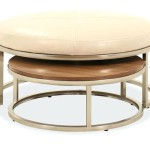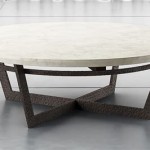How to Make a Round Concrete Coffee Table
Creating a round concrete coffee table offers a unique opportunity to add a modern and durable statement piece to your living space. Concrete's versatility allows for customization in terms of color, texture, and design, making it an excellent choice for a DIY project. This article will guide you through the steps of crafting a stunning round concrete coffee table, equipping you with the necessary knowledge to achieve your desired outcome.
Step 1: Gathering Materials and Tools
Before embarking on your concrete coffee table project, ensure you have the following materials and tools readily available:
- Concrete mix (consider using a pre-mixed bag for convenience)
- Round formwork (a metal bucket, a plastic container, or a custom-made form)
- Release agent (silicone spray or cooking oil)
- Wood screws
- Plywood (for the base and top)
- Sandpaper (various grits)
- Wood stain (optional)
- Polyurethane sealant (optional)
- Power drill
- Circular saw
- Measuring tape
- Level
- Gloves
- Safety goggles
- Dust mask
Remember to choose materials suitable for your desired style and size. For example, a larger coffee table may require a thicker plywood base and a more substantial concrete mix.
Step 2: Constructing the Base and Top
Begin by constructing the base and top of your coffee table. These elements will support the concrete tabletop, ensuring stability and durability. Start by cutting the plywood for the base to the desired dimensions, ensuring a flat and level surface. You can create a simple rectangular base or explore more intricate designs depending on your preferences.
Next, cut the plywood for the top, making it slightly larger than the intended diameter of the concrete tabletop. This will create an overhang that will provide a clean edge for your table. Ensure the top is completely flat and level for a smooth finish.
Step 3: Preparing the Formwork
The formwork plays a crucial role in shaping your concrete tabletop into a perfect round shape. Choose a circular container with a diameter slightly larger than the desired tabletop size. Ensure the container is sturdy and leak-proof, as it will hold the wet concrete during the curing process.
Apply a release agent to the inside of the formwork. This prevents the concrete from sticking to the formwork, making removal easier after the concrete has cured. A light coating of silicone spray or cooking oil will do the job.
Step 4: Mixing and Pouring the Concrete
Follow the instructions on the concrete mix bag for a successful pour. Mix the concrete thoroughly to achieve a smooth and consistent consistency. Avoid overmixing, as this could trap air bubbles, weakening the concrete. Once the concrete is mixed, carefully pour it into the prepared formwork.
Use a trowel to level out the concrete and remove any air bubbles that may have formed. Ensure the concrete fills the formwork evenly, leaving minimal gaps. If needed, use a vibrating tool to consolidate the concrete, preventing voids and ensuring a solid top.
Step 5: Curing and Finishing
Allow the concrete to cure for at least 24 hours. This process allows the concrete to gain strength and stability. During the curing process, cover the concrete tabletop with a damp cloth or plastic sheeting to prevent it from drying too quickly. This will ensure even hydration, promoting a smooth and durable finish.
After the concrete has cured, remove it from the formwork carefully. Use a rubber mallet to gently tap the edges of the formwork, loosening the concrete. If any stubborn areas remain, use a small pry bar to release the concrete from the form.
Step 6: Sanding and Finishing Touches
Sand the concrete surface to create a smooth finish. Start with a coarse sandpaper to remove any rough edges or imperfections, gradually progressing to finer grits for a polished look. You may choose to leave the natural concrete finish or apply a wood stain for a more customized aesthetic.
To protect the concrete surface and enhance its durability, apply a polyurethane sealant. This will create a waterproof barrier, safeguarding the table against spills and wear and tear, extending its lifespan. Always follow the sealant manufacturer's instructions for optimal results.
Step 7: Assembling the Coffee Table
Finally, assemble the components of your coffee table. Secure the base to the bottom of the concrete tabletop using wood screws, ensuring stability. Attach the top to the base, making sure it is level and centered on the supporting structure. You can create a seamless finish by applying wood filler to any screw holes and sanding them smooth.
With the coffee table assembled, you can enjoy your creation. Its unique character and durability will make it a focal point in your living space. Remember to maintain the table by regularly cleaning and reapplying sealant as needed to preserve its beauty and functionality.

Diy Round Concrete Table Top The Inspired Work

Diy Round Concrete Table Top The Inspired Work

Diy Concrete River Table How To Build A Coffee

18 Diy Concrete Coffee And Side Tables

Make A Round Concrete Tabletop

70 Creative Diy Coffee Table Ideas That Are Easy On Pocket Too Concrete Dining Round Patio

How To Make A Round Concrete Table Top Lazy Susan

Sheridan Ombre Coffee Table Outdoor Tables Concrete Diy

Diy Round Concrete Table Top The Inspired Work

18 Diy Concrete Coffee And Side Tables
Related Posts








